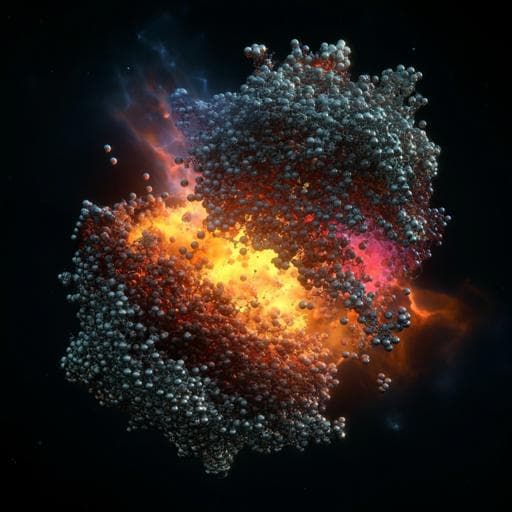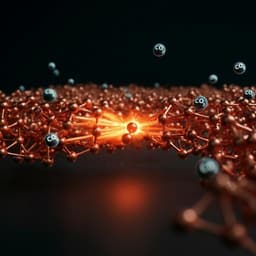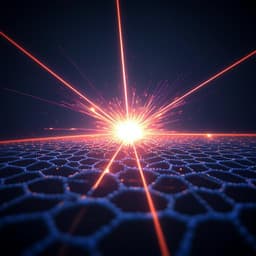
Chemistry
3D atomic-scale imaging of mixed Co-Fe spinel oxide nanoparticles during oxygen evolution reaction
W. Xiang, N. Yang, et al.
Explore the groundbreaking research by Weikai Xiang and colleagues that utilizes atom probe tomography to unveil the 3D structure of nanoparticles crucial for the oxygen evolution reaction. Discover the fascinating nanoscale spinodal decomposition in Co₂FeO₄ and its impact on electrocatalyst performance!
~3 min • Beginner • English
Introduction
Hydrogen production via water electrolysis is limited by the efficiency of anode electrocatalysts for the oxygen evolution reaction (OER). Mixed Co-Fe spinel oxides are promising due to abundance, cost, and rich redox chemistry, but correlating surface atomic-scale composition with activity and stability is challenging, especially for nanoparticles undergoing structural changes under OER conditions. The roles of Fe and Co cation site occupancy (spinel versus inverse spinel) in activity remain debated, and surface reconstructions during OER are not fully understood. This study aims to: (i) correlate OER performance changes with structural and compositional evolution of Co2FeO4 (spinel) and CoFe2O4 (inverse spinel) nanoparticles to elucidate deactivation pathways, and (ii) pinpoint Fe’s role in OER activity. A multiscale approach combining atom probe tomography (APT), XPS, XAS, HRTEM, and EIS is used to probe oxidation states, structures, and 3D compositions during cycling under OER conditions.
Literature Review
Methodology
- Materials synthesis: Co2FeO4 and CoFe2O4 nanoparticles were synthesized hydrothermally from Fe(NO3)3 and Co(NO3)2 with PEG and NH3, autoclaved at 180 °C for 3 h, washed and dried.
- Structural characterization: XRD (Rigaku Ultima IV, Cu Kα) confirmed spinel structure (Fd3m). TEM/HRTEM (JEOL JEM-2200FS, 200 kV) assessed morphology, lattice spacings, and surface phases; FFT and SAED used for phase identification.
- Surface and bulk oxidation states: XPS (Al Kα) monitored Co and Fe 2p states and satellite features pre- and post-cycling. XAS/HERFD-XAS and XES (Diamond Light Source) probed bulk Co and Fe K-edges for oxidation state and coordination changes.
- Electrochemistry: LSV for OER activity (10 mV/s) and CV (50 mV/s) in 1.0 M KOH on RDE; currents normalized to BET surface area from N2 physisorption (TriStar II 3020). iR compensation applied using RΩ from EIS. Additional electrochemistry performed in 1.0 M KOD in D2O to prepare APT specimens. EIS (6 kHz–0.2 Hz, 10 mV) analyzed with equivalent circuit fitting and distribution of relaxation times.
- Atom probe tomography: Nanoparticles deposited on glassy carbon were cycled (100, 500, 1000 CV cycles) in KOD/D2O, then embedded by Ni electrodeposition. Needle specimens prepared by FIB lift-out (FEI Helios G4 CX). APT on CAMECA LEAP 5000XR (laser pulsing, 57 K, 30 pJ, 125 kHz, 0.5% detection). 3D reconstructions analyzed with IVAS. Stoichiometry considerations calibrated using H2-TPR and laser energy effects.
- H2-TPR: Flow system with TCD measured reducible oxygen to help normalize APT O/(Co+Fe) ratios.
- N2 physisorption: BET surface areas measured after degassing.
Key Findings
- Structure and size: Both Co2FeO4 and CoFe2O4 nanoparticles are cubic spinel, spherical, ~10.3 ± 2.6 nm and 10.4 ± 2.7 nm, with lattice constants 8.60 Å and 8.69 Å, respectively.
- OER activity: Pristine Co2FeO4 outperforms CoFe2O4. Overpotential at 10 μA/cm²: 359 mV (Co2FeO4) vs 432 mV (CoFe2O4). Tafel slopes: 43 ± 1 mV/dec (Co2FeO4) vs 79 ± 2 mV/dec (CoFe2O4). With cycling, activity deteriorates for both; after 1000 cycles, Tafel slope for Co2FeO4 rises to 83 ± 2 mV/dec, CoFe2O4 to 83 ± 1 mV/dec.
- Electrochemical signatures: Co2FeO4 shows Co(II)/Co(III) and Co(III)/Co(IV) redox peaks initially, which diminish by 1000 cycles, indicating irreversibility. CoFe2O4 shows minimal redox features with slight anodic shift.
- Oxidation states (XPS/XAS): Co2FeO4 surface Co(II) decreases after 100 cycles with increase of Co3O4-like Co; after 1000 cycles Co(III) and likely Co(IV) present. Fe remains Fe(III) at surface for both materials throughout. XAS indicates small bulk shift toward higher Co oxidation and increased octahedral coordination post-cycling.
- HRTEM surface transformations: Co2FeO4 forms crystalline (Co,Fe)OOH on surface after 100 cycles (epitaxial relation), and after 1000 cycles a 5–6 nm transformed surface region consistent with CoO2 (octahedral Co(IV)) forms. CoFe2O4 shows little change after 100 cycles; after 1000 cycles, surface transforms to a phase consistent with Fe2O3/(Fe,Co)2O3.
- APT 3D composition: Among 48 pristine Co2FeO4 NPs, 26 exhibit nanoscale compositional modulation (segregation) into Co-rich and Fe-rich nanodomains (~4–5 nm), attributed to spinodal decomposition. Initial Co/Fe ratios: Fe-rich 1.2 ± 0.1; Co-rich 2.2 ± 0.1. O/(Co+Fe) (O/M): Fe-rich 1.2 ± 0.1; Co-rich 1.3 ± 0.1. Non-segregated Co2FeO4 shows uniform Co and Fe (approximate stoichiometry Co1.7Fe1.3O3.3). CoFe2O4 (39 NPs) shows no segregation; stoichiometry ~CoFe2O3.6.
- Hydroxyl trapping: In Co2FeO4, hydroxyl groups (from KOD/D2O measurements) preferentially locate at interfaces between Co-rich and Fe-rich domains after 100–500 cycles, and become dominant in Fe-rich regions after 1000 cycles, indicating OER-active regions.
- Fe dissolution and oxidation: In segregated Co2FeO4, Co-rich domains show increasing Co/Fe with cycling (to ~2.8 at 500 cycles, ~2.9 at 1000 cycles) indicating Fe loss; O/M increases to ~1.6 by 1000 cycles. Fe-rich domains O/M also increases (~1.5 at 1000 cycles). Non-segregated Co2FeO4 develops 2–3 nm O-rich surface regions (O/M ~1.4 after 100 cycles to ~1.8 after 1000 cycles) with slight Co/Fe increase, consistent with (Co,Fe)OOH then (Co,Fe)O2 formation and Fe loss.
- CoFe2O4 stability: Minimal Fe loss; 2–3 nm O-rich surface layers appear after 500–1000 cycles (O/M ~1.7–1.8), consistent with formation of (Fe,Co)2O3; Co(II) oxidizes to Co(III).
- EIS: Co2FeO4 exhibits multiple relaxation processes and pseudocapacitive behavior (associated with Co redox and adsorption of oxygen-containing species); faradaic resistances increase with cycling, correlating with deactivation and structural transformations to oxyhydroxide and oxide phases. CoFe2O4 shows a single semicircle, no pseudocapacitance, and increasing resistance with cycles.
- Mechanistic insight: Higher initial activity of Co2FeO4 arises from interfaces that trap OH and from Fe’s promotion of Co oxyhydroxide active species (likely CoIII–FeOOH). Deactivation is driven by Fe dissolution (e.g., ferrate formation in alkaline media) and irreversible surface transformation to (CoIV,Fe)O2. CoFe2O4 deactivates due to oxidation to Co(III) and surface (FeIII,CoIII)2O3 formation.
Discussion
The findings establish a direct relationship between nanoscale 3D composition/structure and OER activity and stability. In Co2FeO4, spinodal decomposition creates Co-rich and Fe-rich nanodomains whose interfaces concentrate hydroxyl groups, providing active regions that lower overpotential and Tafel slope compared to CoFe2O4. Fe, in the presence of Co(II) at tetrahedral sites, promotes the formation and activity of Co oxyhydroxide species (e.g., CoIII–FeOOH), enhancing OER kinetics. However, under prolonged cycling, Fe dissolution is most pronounced in Co-rich domains, and concurrent irreversible transformation toward CoO2-like surface phases increases charge-transfer resistance and diminishes pseudocapacitive contributions, leading to deactivation. In CoFe2O4, the absence of segregation and limited Fe dissolution lead to more stable composition but with lower intrinsic activity; surface oxidation to (Fe,Co)2O3 and Co(II) to Co(III) conversion slightly deteriorate performance over cycles. EIS corroborates that increasing faradaic resistances track the observed increases in overpotential. Overall, atomic-scale mapping links specific nanoscale features (domain interfaces, cation distribution, oxidation states) to both activation and degradation pathways during OER.
Conclusion
This work provides atomic-scale, three-dimensional insight into the structural and compositional evolution of Co2FeO4 and CoFe2O4 nanoparticles under OER. Pristine Co2FeO4 contains Co-rich/Fe-rich nanodomains formed by spinodal decomposition; their interfaces trap hydroxyl groups and, together with Fe-assisted formation of Co oxyhydroxide species, confer superior initial OER activity relative to CoFe2O4. Deactivation of Co2FeO4 arises from Fe dissolution and irreversible surface transformation to CoO2-like phases, while CoFe2O4 primarily forms a surface (Fe,Co)2O3 layer with minimal Fe loss, leading to modest deactivation. The integrated APT, XPS, XAS, HRTEM, and EIS approach demonstrates the value of 3D atomic-scale analysis to uncover active sites and degradation mechanisms in electrocatalysts.
Potential future directions include: engineering domain interfaces to maximize beneficial OH trapping while mitigating Fe dissolution; stabilizing Fe in mixed Co-Fe oxyhydroxide environments; controlling cation site occupancy to optimize Co(II) tetrahedral site availability; and extending this multimodal methodology to other mixed-oxide systems and reactions.
Limitations
- XPS cannot unambiguously distinguish Co(IV) from Co3O4-like Co states; Co(IV) inference relies on combined electrochemical, TEM, and XAS evidence.
- XAS predominantly probes bulk; observed oxidation state shifts likely reflect surface-confined changes, potentially underestimating surface transformations.
- TEM/HRTEM observations are ex situ under high vacuum; crystalline oxyhydroxide formation may result from post-reaction crystallization, and amorphous surface layers can include electron-beam-induced carbon contamination.
- APT stoichiometry of oxides is sensitive to laser pulsing conditions; oxygen quantification was normalized using H2-TPR and assessed for laser energy effects, but residual uncertainty remains.
- Electrochemical conditions differed between KOH (for activity metrics) and KOD/D2O (for APT sample preparation), which could subtly affect surface species and kinetics.
- Embedding nanoparticles in a Ni matrix for APT and ex situ analysis may not capture transient operando states at potential during OER.
Related Publications
Explore these studies to deepen your understanding of the subject.







